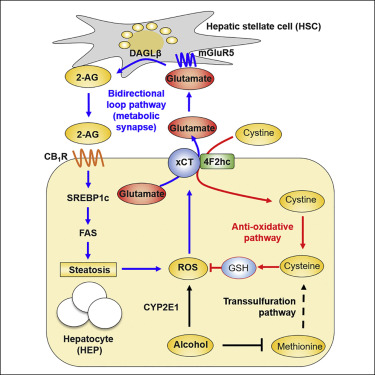当前位置:
X-MOL 学术
›
Cell Metab.
›
论文详情
Our official English website, www.x-mol.net, welcomes your feedback! (Note: you will need to create a separate account there.)
Glutamate Signaling in Hepatic Stellate Cells Drives Alcoholic Steatosis.
Cell Metabolism ( IF 29.0 ) Pub Date : 2019-08-29 , DOI: 10.1016/j.cmet.2019.08.001 Won-Mook Choi 1 , Hee-Hoon Kim 2 , Myung-Ho Kim 2 , Resat Cinar 3 , Hyon-Seung Yi 4 , Hyuk Soo Eun 4 , Seok-Hwan Kim 5 , Young Jae Choi 6 , Young-Sun Lee 7 , So Yeon Kim 2 , Wonhyo Seo 8 , Jun-Hee Lee 2 , Young-Ri Shim 2 , Ye Eun Kim 2 , Keungmo Yang 2 , Tom Ryu 2 , Jung Hwan Hwang 9 , Chul-Ho Lee 9 , Hueng-Sik Choi 10 , Bin Gao 11 , Won Kim 12 , Sang Kyum Kim 6 , George Kunos 3 , Won-Il Jeong 2
Cell Metabolism ( IF 29.0 ) Pub Date : 2019-08-29 , DOI: 10.1016/j.cmet.2019.08.001 Won-Mook Choi 1 , Hee-Hoon Kim 2 , Myung-Ho Kim 2 , Resat Cinar 3 , Hyon-Seung Yi 4 , Hyuk Soo Eun 4 , Seok-Hwan Kim 5 , Young Jae Choi 6 , Young-Sun Lee 7 , So Yeon Kim 2 , Wonhyo Seo 8 , Jun-Hee Lee 2 , Young-Ri Shim 2 , Ye Eun Kim 2 , Keungmo Yang 2 , Tom Ryu 2 , Jung Hwan Hwang 9 , Chul-Ho Lee 9 , Hueng-Sik Choi 10 , Bin Gao 11 , Won Kim 12 , Sang Kyum Kim 6 , George Kunos 3 , Won-Il Jeong 2
Affiliation

|
Activation of hepatocyte cannabinoid receptor-1 (CB1R) by hepatic stellate cell (HSC)-derived 2-arachidonoylglycerol (2-AG) drives de novo lipogenesis in alcoholic liver disease (ALD). How alcohol stimulates 2-AG production in HSCs is unknown. Here, we report that chronic alcohol consumption induced hepatic cysteine deficiency and subsequent glutathione depletion by impaired transsulfuration pathway. A compensatory increase in hepatic cystine-glutamate anti-porter xCT boosted extracellular glutamate levels coupled to cystine uptake both in mice and in patients with ALD. Alcohol also induced the selective expression of metabotropic glutamate receptor-5 (mGluR5) in HSCs where mGluR5 activation stimulated 2-AG production. Consistently, genetic or pharmacologic inhibition of mGluR5 or xCT attenuated alcoholic steatosis in mice via the suppression of 2-AG production and subsequent CB1R-mediated de novo lipogenesis. We conclude that a bidirectional signaling operates at a metabolic synapse between hepatocytes and HSCs through xCT-mediated glutamate-mGluR5 signaling to produce 2-AG, which induces CB1R-mediated alcoholic steatosis.
中文翻译:

肝星状细胞中的谷氨酸信号驱动酒精性脂肪变性。
肝星状细胞(HSC)衍生的2-花生四烯酰甘油(2-AG)对肝细胞大麻素受体1(CB1R)的激活驱动了酒精性肝病(ALD)的新生脂肪形成。酒精如何刺激HSCs中2-AG的产生尚不清楚。在这里,我们报告说,长期饮酒会导致肝半胱氨酸缺乏,并随后通过受损的转硫途径减少谷胱甘肽的消耗。小鼠和ALD患者肝脏中胱氨酸-谷氨酸抗转运蛋白xCT的代偿性增加可提高细胞外谷氨酸水平,并与胱氨酸的摄取相关。酒精还诱导了HSCs中代谢型谷氨酸受体5(mGluR5)的选择性表达,其中mGluR5的激活刺激了2-AG的产生。始终如一 通过抑制2-AG产生和随后CB1R介导的新生脂肪生成,mGluR5或xCT的遗传或药理抑制作用可减轻小鼠的酒精性脂肪变性。我们得出结论,双向信号传导通过xCT介导的谷氨酸-mGluR5信号传导在肝细胞和HSC之间的代谢突触产生2-AG,从而诱导CB1R介导的酒精性脂肪变性。
更新日期:2019-11-09
中文翻译:

肝星状细胞中的谷氨酸信号驱动酒精性脂肪变性。
肝星状细胞(HSC)衍生的2-花生四烯酰甘油(2-AG)对肝细胞大麻素受体1(CB1R)的激活驱动了酒精性肝病(ALD)的新生脂肪形成。酒精如何刺激HSCs中2-AG的产生尚不清楚。在这里,我们报告说,长期饮酒会导致肝半胱氨酸缺乏,并随后通过受损的转硫途径减少谷胱甘肽的消耗。小鼠和ALD患者肝脏中胱氨酸-谷氨酸抗转运蛋白xCT的代偿性增加可提高细胞外谷氨酸水平,并与胱氨酸的摄取相关。酒精还诱导了HSCs中代谢型谷氨酸受体5(mGluR5)的选择性表达,其中mGluR5的激活刺激了2-AG的产生。始终如一 通过抑制2-AG产生和随后CB1R介导的新生脂肪生成,mGluR5或xCT的遗传或药理抑制作用可减轻小鼠的酒精性脂肪变性。我们得出结论,双向信号传导通过xCT介导的谷氨酸-mGluR5信号传导在肝细胞和HSC之间的代谢突触产生2-AG,从而诱导CB1R介导的酒精性脂肪变性。


























 京公网安备 11010802027423号
京公网安备 11010802027423号